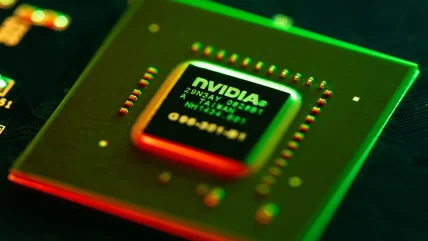
Nvidia experienced a historic single-day loss in market value on Tuesday as the company’s shares fell by 9.5%, leading to a $279bn reduction in market capitalisation. This marks the largest one-day decline in market value for any US company, surpassing the previous record held by Meta Platforms, which lost $232bn on 3 February 2022.
Nvidia’s sharp decline was triggered by its recent quarterly outlook, which fell short of the high expectations set by investors. The company has recently become one of the most valuable globally, due to a surge in interest and investment in artificial intelligence (AI) technologies, particularly generative AI. Its market capitalisation had surpassed other tech giants, such as Alphabet and Amazon, driven by its leadership in AI chip manufacturing.
Nvidia’s results disappointing to the market, despite being stellar
Nvidia reported a GAAP net income of $16.6bn for Q2 FY25, marking a 168% increase year-on-year. The company’s total revenue for the quarter reached $30bn, up 122% from $13.5bn in Q2 FY24. For Q3 FY25, Nvidia forecasts revenue to be around $32.5bn, with a possible variance of plus or minus 2%.
However, investor sentiment appears to have shifted amid concerns over slower-than-expected returns on substantial investments in AI. The broader market also reflected this pullback, with the PHLX Semiconductor Index falling by 7.75%, its largest single-day drop since 2020. Key indices such as the Nasdaq and S&P 500 were also affected, dropping by 3.3% and 2.1%, respectively, amid economic uncertainties and doubts over AI’s near-term profitability.
Nvidia’s decline comes after an extensive rally earlier this year, where its stock nearly tripled. Despite the setback, Nvidia’s stock remains significantly higher on a year-to-date basis, with an increase of 118%. This market reaction signals a recalibration of expectations regarding AI’s growth potential and the associated timelines for meaningful financial returns from these investments.
This re-evaluation of AI’s profitability also affected other tech giants, such as Microsoft and Alphabet, whose stocks have been trading lower following recent quarterly results. The situation reflects a broader trend of caution among investors as they wait for more concrete signs of sustainable growth in the AI sector.
The GPU giant falters
Nvidia’s dominant position in AI and semiconductor markets is bolstered by its graphics processing units (GPUs), which are essential for AI model training, and its advancements in data centre chips, such as the Grace Hopper superchips. The company’s growth has been significant, driven by the AI boom and expanding data centre demands.
However, analysts warn of challenges ahead, including market volatility, economic uncertainties, and growing competition from other tech giants. Sustaining growth will require Nvidia to continue innovating and expanding its product lines to maintain its edge in a rapidly evolving landscape. Despite these challenges, Nvidia’s strong positioning suggests the potential for continued leadership in AI hardware if it can effectively navigate these hurdles.
Meanwhile, Intel’s status in the Dow Jones Industrial Average is under threat due to a sharp decline in its stock price, which has fallen nearly 60% this year, making it the worst performer on the index.
The decline is attributed to missed opportunities in the AI sector, manufacturing delays, and geopolitical tensions affecting its supply chain. Analysts suggest Intel could be removed from the Dow, potentially being replaced by companies like Nvidia or Texas Instruments, as it struggles to regain its competitive edge in the semiconductor market.
Written by Swagath Bandhakavi






